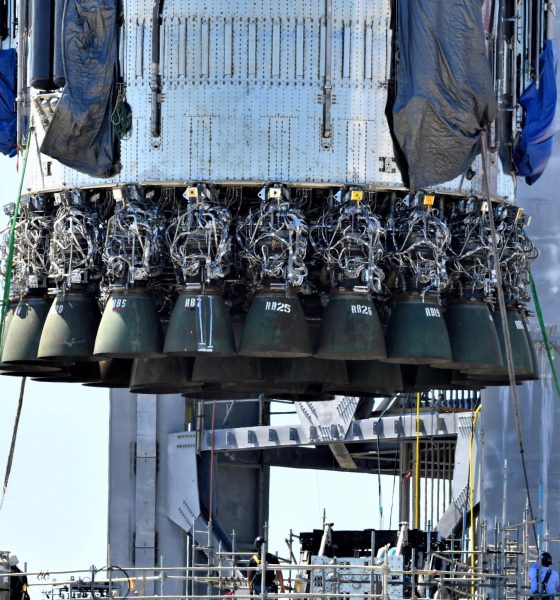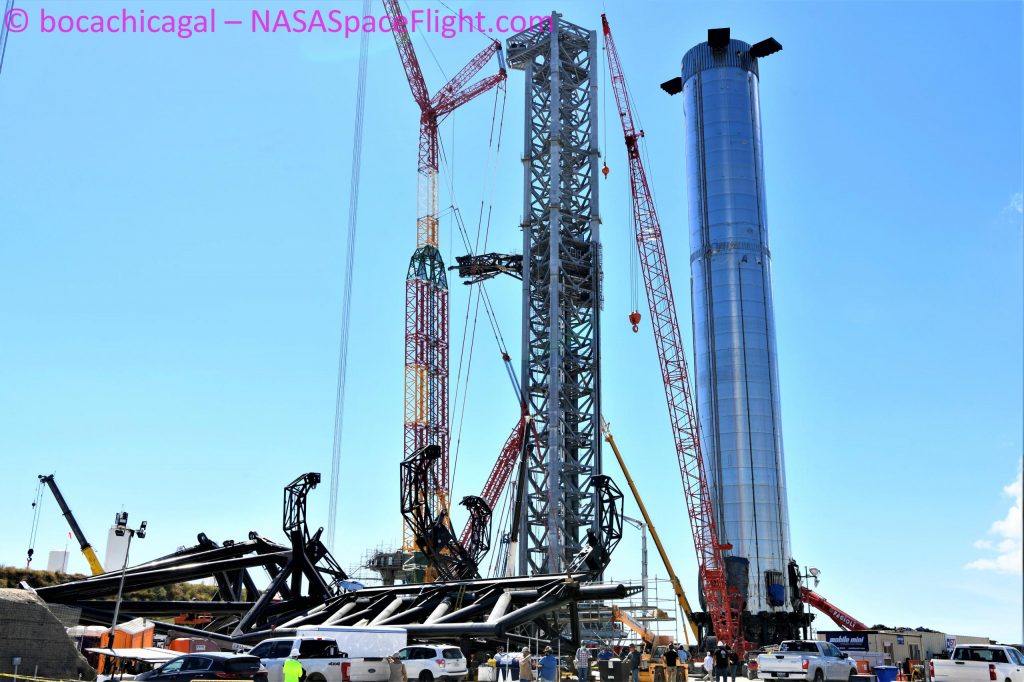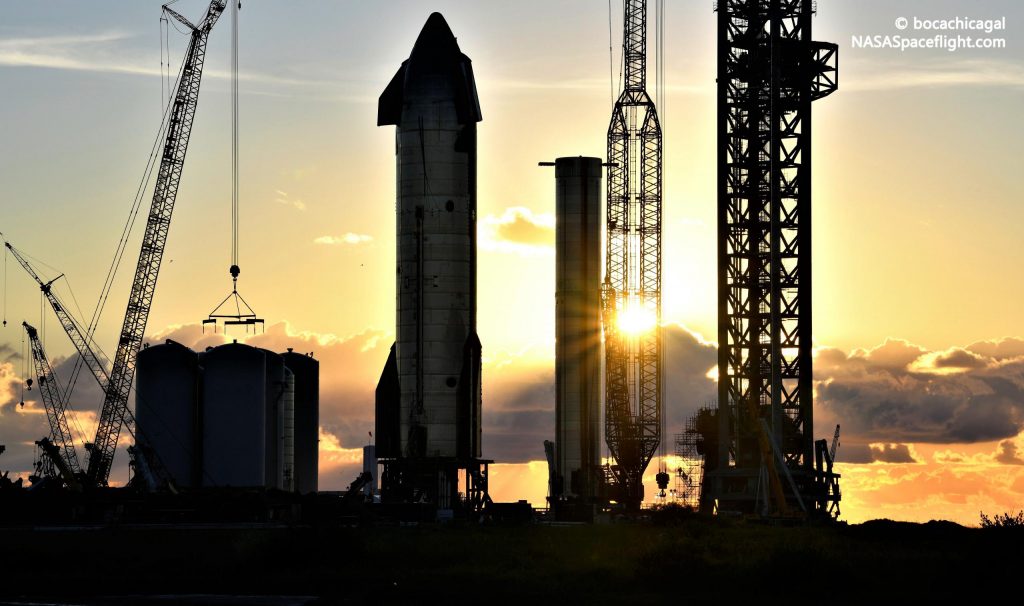

News
SpaceX moves Super Heavy booster to make room for Mechazilla arm installation
For the second time, SpaceX has removed the first potentially flightworthy Super Heavy from Starbase’s orbital launch mount – this time to reportedly make room for the installation of a pair of huge ‘Mechazilla’ arms.
Designed with three primary purposes in mind, SpaceX has decided to outfit Starbase’s Starship launch tower – an almost 500 ft (150m) tall framework – with three massive arms that CEO Elon Musk has informally deemed “Mechazilla.” The first of those arms is a relatively simple swinging structure that has already been installed on the tower and outfitted with a giant claw-like appendage. Once a few more parts are installed and a bit more plumbing completed, that “quick disconnect arm” or QD arm will help stabilize Super Heavy during Starship installation and connect the massive reusable upper stage to the pad’s tank farm and power supplies while still on the ground.
The star of the show, though, has always been a pair of even larger arms that are hoped to one day all SpaceX to catch Super Heavy boosters and Starships out of the air.
Of course, those catcher arms – deemed chopsticks by SpaceX employees – have more than one purpose. Likely explaining why they were ever considered in the first place, SpaceX’s Starbase launch site – situated walking distance from the Gulf of Mexico on the South Texas coast – was always going to have to deal with extreme weather and high winds on a practically daily basis. Additionally, conditions that are already disruptive at sea level become a near-constant nightmare for vertical launch vehicle integration, where Starship and Super Heavy are effectively hollow cylinders with extensive surface areas that need to be regularly and precisely manipulated 50-150m (200-450 ft) above the ground.
Already, SpaceX regularly has to halt work involving cranes and boom lifts at Starbase. For Starbase (Boca Chica) to ever be able to support regular orbital Starship launches, let alone the dozens to hundreds per year Musk has hinted at, cranes were never going to be a viable long-term solution for the all-weather capabilities and rapid reusability SpaceX requires. In other words, whether SpaceX ever actually manages to routinely ‘catch’ the world’s largest rocket booster and upper stage in the future, a tower with giant arms (or some other exotic crane-free solution) was always going to be needed at Starbase.
Mauricio, thanks for the shout-out. I got some great feedback from folks and updated this diagram once more. Added another @NicAnsuini photo to show the scale of these parts! pic.twitter.com/o54hdBITfL— LunarCaveman (@LunarCaveman) September 16, 2021

This is all to say that the Starship launch tower’s massive pair of arms – (in)famous for Musk’s plans to catch rockets – have a more immediate and guaranteed purpose: lifting, stacking, and otherwise manipulating Starship and Super Heavy in almost all weather conditions. Using tiny hardpoints located just under Super Heavy’s grid fins and (once installed) under Starship’s forward flaps, the chopstick arms will be mounted on a carriage that will attach to rails installed on the exterior of three of the tower’s arms. A complex system of cables, winches, motors, and pulleys will then attach to that carriage, giving the carriage and its arms the ability to move up and down the tower.
In theory, that means that the launch tower arms will be able to drop down, grab Super Heavy off of a SpaceX transporter, and lift it onto the orbital launch mount. Then, once the quick disconnect arm has swung into place and ‘grabbed’ Super Heavy’s interstage to secure it, the main arms will again drop down, grab Starship off of another transporter, and raise the 50m (~165 ft) rocket around 100m off the ground to install it on top of Super Heavy. Finally, the QD arm can then connect Starship to the pad systems.


SpaceX has been working around the clock on those chopstick arms for months. However, thanks to information shared by a forum member who visited Starbase and briefly chatted with one of the SpaceX technicians on-site, they might be almost finished. According to the employee they spoke with, SpaceX planned to temporarily remove Super Heavy Booster 4 from the orbital launch mount to make room for Mechazilla chopstick arm installation as early as this weekend (now come and gone) or next week. Mere days later, SpaceX returned B4 to a transport stand and moved the booster out of the way. In other words, having already been proven right with Super Heavy, it appears that SpaceX really does intend to install the Starship launch tower’s chopstick arms and carriage as early as this week. Stay tuned for more!

Elon Musk
Elon Musk’s X will start using a Tesla-like software update strategy
The initiative seems designed to accelerate updates to the social media platform, while maintaining maximum transparency.

Elon Musk’s social media platform X will adopt a Tesla-esque approach to software updates for its algorithm.
The initiative seems designed to accelerate updates to the social media platform, while maintaining maximum transparency.
X’s updates to its updates
As per Musk in a post on X, the social media company will be making a new algorithm to determine what organic and advertising posts are recommended to users. These updates would then be repeated every four weeks.
“We will make the new 𝕏 algorithm, including all code used to determine what organic and advertising posts are recommended to users, open source in 7 days. This will be repeated every 4 weeks, with comprehensive developer notes, to help you understand what changed,” Musk wrote in his post.
The initiative somewhat mirrors Tesla’s over-the-air update model, where vehicle software is regularly refined and pushed to users with detailed release notes. This should allow users to better understand the details of X’s every update and foster a healthy feedback loop for the social media platform.
xAI and X
X, formerly Twitter, has been acquired by Elon Musk’s artificial intelligence startup, xAI last year. Since then, xAI has seen a rapid rise in valuation. Following the company’s the company’s upsized $20 billion Series E funding round, estimates now suggest that xAI is worth tens about $230 to $235 billion. That’s several times larger than Tesla when Elon Musk received his controversial 2018 CEO Performance Award.
As per xAI, the Series E funding round attracted a diverse group of investors, including Valor Equity Partners, Stepstone Group, Fidelity Management & Research Company, Qatar Investment Authority, MGX, and Baron Capital Group, among others. Strategic partners NVIDIA and Cisco Investments also continued support for building the world’s largest GPU clusters.
News
Tesla FSD Supervised wins MotorTrend’s Best Driver Assistance Award
The decision marks a notable reversal for the publication from prior years, with judges citing major real-world improvements that pushed Tesla’s latest FSD software ahead of every competing ADAS system.

Tesla’s Full Self-Driving (Supervised) system has been named the best driver-assistance technology on the market, earning top honors at the 2026 MotorTrend Best Tech Awards.
The decision marks a notable reversal for the publication from prior years, with judges citing major real-world improvements that pushed Tesla’s latest FSD software ahead of every competing ADAS system. And it wasn’t even close.
MotorTrend reverses course
MotorTrend awarded Tesla FSD (Supervised) its 2026 Best Tech Driver Assistance title after extensive testing of the latest v14 software. The publication acknowledged that it had previously criticized earlier versions of FSD for erratic behavior and near-miss incidents, ultimately favoring rivals such as GM’s Super Cruise in earlier evaluations.
According to MotorTrend, the newest iteration of FSD resolved many of those shortcomings. Testers said v14 showed far smoother behavior in complex urban scenarios, including unprotected left turns, traffic circles, emergency vehicles, and dense city streets. While the system still requires constant driver supervision, judges concluded that no other advanced driver-assistance system currently matches its breadth of capability.
Unlike rival systems that rely on combinations of cameras, radar, lidar, and mapped highways, Tesla’s FSD operates using a camera-only approach and is capable of driving on city streets, rural roads, and freeways. MotorTrend stated that pure utility, the ability to handle nearly all road types, ultimately separated FSD from competitors like Ford BlueCruise, GM Super Cruise, and BMW’s Highway Assistant.
High cost and high capability
MotorTrend also addressed FSD’s pricing, which remains significantly higher than rival systems. Tesla currently charges $8,000 for a one-time purchase or $99 per month for a subscription, compared with far lower upfront and subscription costs from other automakers. The publication noted that the premium is justified given FSD’s unmatched scope and continuous software evolution.
Safety remained a central focus of the evaluation. While testers reported collision-free operation over thousands of miles, they noted ongoing concerns around FSD’s configurable driving modes, including options that allow aggressive driving and speeds beyond posted limits. MotorTrend emphasized that, like all Level 2 systems, FSD still depends on a fully attentive human driver at all times.
Despite those caveats, the publication concluded that Tesla’s rapid software progress fundamentally reshaped the competitive landscape. For drivers seeking the most capable hands-on driver-assistance system available today, MotorTrend concluded Tesla FSD (Supervised) now stands alone at the top.
News
Elon Musk’s Grokipedia surges to 5.6M articles, almost 79% of English Wikipedia
The explosive growth marks a major milestone for the AI-powered online encyclopedia, which was launched by Elon Musk’s xAI just months ago.

Elon Musk’s Grokipedia has grown to an impressive 5,615,201 articles as of today, closing in on 79% of the English Wikipedia’s current total of 7,119,376 articles.
The explosive growth marks a major milestone for the AI-powered online encyclopedia, which was launched by Elon Musk’s xAI just months ago. Needless to say, it would only be a matter of time before Grokipedia exceeds English Wikipedia in sheer volume.
Grokipedia’s rapid growth
xAI’s vision for Grokipedia emphasizes neutrality, while Grok’s reasoning capabilities allow for fast drafting and fact-checking. When Elon Musk announced the initiative in late September 2025, he noted that Grokipedia would be an improvement to Wikipedia because it would be designed to avoid bias.
At the time, Musk noted that Grokipedia “is a necessary step towards the xAI goal of understanding the Universe.”
Grokipedia was launched in late October, and while xAI was careful to list it only as Version 0.1 at the time, the online encyclopedia immediately earned praise. Wikipedia co-founder Larry Sanger highlighted the project’s innovative approach, noting how it leverages AI to fill knowledge gaps and enable rapid updates. Netizens also observed how Grokipedia tends to present articles in a more objective manner compared to Wikipedia, which is edited by humans.
Elon Musk’s ambitious plans
With 5,615,201 total articles, Grokipedia has now grown to almost 79% of English Wikipedia’s article base. This is incredibly quick, though Grokipedia remains text-only for now. xAI, for its part, has now updated the online encyclopedia’s iteration to v0.2.
Elon Musk has shared bold ideas for Grokipedia, including sending a record of the entire knowledge base to space as part of xAI’s mission to preserve and expand human understanding. At some point, Musk stated that Grokipedia will be renamed to Encyclopedia Galactica, and it will be sent to the cosmos.
“When Grokipedia is good enough (long way to go), we will change the name to Encyclopedia Galactica. It will be an open source distillation of all knowledge, including audio, images and video. Join xAI to help build the sci-fi version of the Library of Alexandria!” Musk wrote, adding in a later post that “Copies will be etched in stone and sent to the Moon, Mars and beyond. This time, it will not be lost.”








